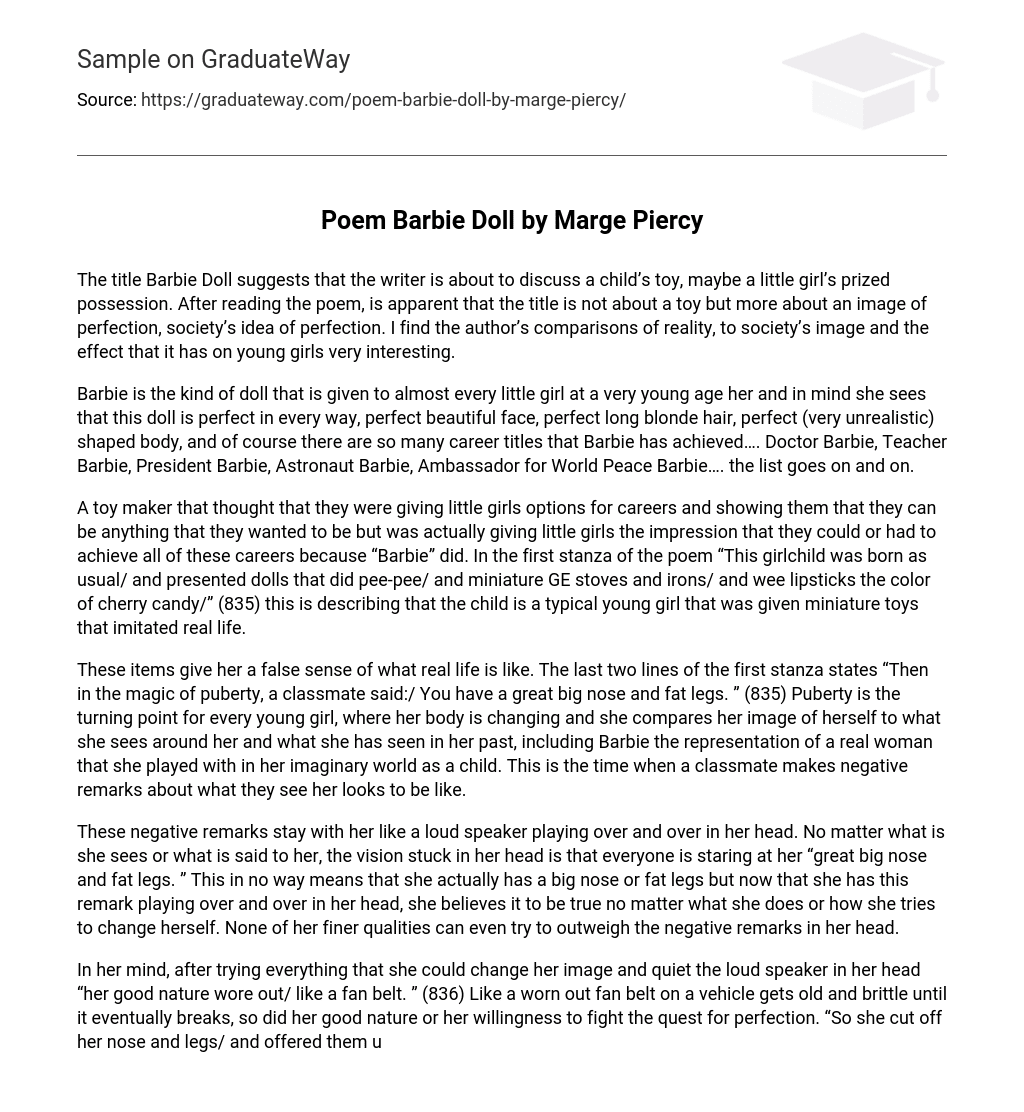The poem’s title, Barbie Doll, initially suggests that it will focus on a child’s toy, perhaps a cherished possession of a young girl. However, upon reading the poem, it becomes clear that the title actually addresses the concept of perfection and how society perceives it. I am particularly intrigued by the author’s reflections on the differences between reality and society’s ideals, and the impact this has on young girls.
Barbie is a doll that is typically gifted to young girls at a very early age. These girls see Barbie as flawless in every aspect, from her beautiful face and long blonde hair to her idealized body shape (although highly unrealistic). Additionally, Barbie has successfully held various professional roles, such as Doctor Barbie, Teacher Barbie, President Barbie, Astronaut Barbie, and Ambassador for World Peace Barbie, among many others.
The toy maker believed they were providing diverse career options for young girls, encouraging them to pursue any profession they desired. However, this unintentionally created the perception that they must achieve all these careers solely because Barbie represented them. The first stanza of the poem “This girlchild was born as usual/ and presented dolls that did pee-pee/ and miniature GE stoves and irons/ and wee lipsticks the color of cherry candy/” (835) illustrates how the child, like any other girl, received tiny toys imitating aspects of real life.
These items give her a false sense of reality. In the first stanza, it is mentioned that during puberty, a classmate insults her by saying she has a big nose and fat legs. Puberty is a crucial stage for girls, where they experience bodily changes and compare themselves to others and past influences, including Barbie dolls. It is during this time that negative comments about her appearance are made by a classmate.
These negative remarks persist in her mind like a constant reminder. Regardless of what she observes or hears, her perception is dominated by the idea that everyone is scrutinizing her “enormous nose and chunky legs.” This does not imply that she physically possesses a large nose or fat legs. However, the repetition of this comment in her mind convinces her of its truth, no matter her efforts or attempts to transform herself. Even her positive qualities cannot outweigh the relentless negativity echoing in her thoughts.
In her mind, she exhausted every effort to alter her image and silence the relentless voice inside her head that said “her good nature wore out/ like a fan belt” (836). Just like an aging and fragile fan belt on a vehicle, her good nature or determination to combat the pursuit of perfection eventually deteriorated and snapped. “So she cut off her nose and legs/ and offered them up.” These lines convey her acknowledgement of defeat and the removal of those flawed aspects that are beyond her control. She has surrendered to life because she cannot achieve her idealized notion of perfection, thus failing to conform to society’s expectations of who she should be.
The final verse illustrates her lifeless body in the coffin at her funeral, adorned with flawlessly applied makeup and a newly crafted putty nose, delicately molded exclusively for her. In customary funeral fashion, only complimentary words are uttered about her, as it is deemed impolite to speak ill after one has departed. Perhaps these remarks would have been more beneficial if they were voiced to her while she still lived, though they likely would not have quieted the resounding echo in her mind that dictated her self-perception.
The author ends the text by using wordplay to suggest that the woman’s happiness can only be achieved in death, as she is no longer burdened by societal expectations. This emphasizes the author’s message about how society’s beauty standards and low self-esteem are negatively impacting young women, leading to both psychological and physical harm.
I found the author’s words and comparisons to be effective, clearly conveying their message. Despite being written in 1973, the meaning of these words still holds true in 2009. It makes me ponder whether society will ever grasp that they have the power to change this perception and make a difference. The profound truth it portrays, that true happiness is unattainable, fills me with sadness.
Piercy, Marge. “Barbie Doll.” @ The Norton Introduction to Literature. 9th ed. Ed. Alison Booth, J. Paul Hunter, and Kelly J. Mays. New York: Norton, 2005. 835-36. Print





